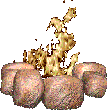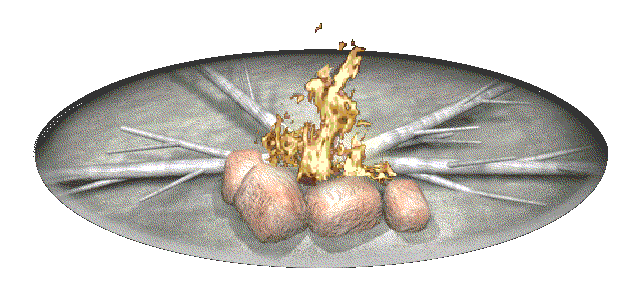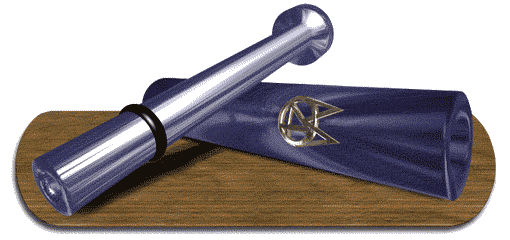 SURVIVAL SKILLS
- FIRE
SURVIVAL SKILLS
- FIRE SURVIVAL SKILLS
- FIRE
SURVIVAL SKILLS
- FIRE
Note - On this, the Fire Making Page, the cursor trailer is my pathetic attempt at creating a spark effect. Sorry if it's a bit annoying!
Fire is one of the most basic skills to have, yet it is quite amazing how many people can't start a fire without dry wood and fuel at hand. I won't go into minute detail on this subject, as there are plenty of sites out there that already do. This site is made primarily for those who already have some modicum of outdoor skills. Fire is a skill that should be practiced by anyone who spends time away from civilization. Anyone can practice making fire in their backyard. Fire is the means to warmth, water purification, cooking food, and a general sense of well being. The following tips will help you to start fires in less than ideal conditions with limited tools (I practice with flint and steel, but prefer a lighter when available).
Rule number one for a fire is similar to that for shelter... LOCATION, LOCATION, LOCATION!!! Find a place that is out of the wind and elements, that has ample fuel at hand, and that doesn't cause a hazard. It's hard enough surviving in a forest, it's even harder trying to survive in a forest fire! The more you do in preparation before ever striking a match, the easier it will be to start and maintain a fire. A large boulder is usually a prime place to build a fire. Besides acting as a wind break, it will also reflect warmth back at you, and will keep the smoke flowing up the side of the rock face, and out of your eyes.
Make your fire as small as possible... you'll use less wood, and therefore less energy. If you're using the fire as a signal, you can still keep it small, yet have a large pile of dry material ready to throw on at a moment's notice.
To build a typical campfire, you'll need three types of fuel . These are Tinder, kindling, and logs. The first rule of fire making is to always have twice as much of each as you think you'll need. Have these ready before you ever strike a match. Whereas the logs and kindling are typically just little sticks and big sticks arranged in a nice tepee or log cabin arrangement, I will not waste time comparing the burn rates of different types, etc. In a survival situation, the hard part is getting the first flame to take to your tinder. Once you have a nice little pile of tinder material burning, it's relatively easy to get the rest of the fire going, so I will not waste time explaining it. I will focus on some tinder sources and tips.
Know your tinder sources! There are a multitude of mosses, grasses, and other thin and fibery materials that can be easily ignited. A key to these is that they need to be dry. When walking along in the woods, I collect wispy looking materials, and put them in my shirt pocket (body heat dries them out in a hurry). Some other great tinder that will light in just about any conditions are as follows
TYPES OF FIRE
LAZY MAN FIRE - Fire making is not all about starting the fire... sometimes it's about how you maintain it! Here's a type of fire called a "Lazy Man's Fire". If you are in a survival situation, save your energy. Don't burn energy chopping firewood. Feed large branches and logs into the fire, and let the fire do all the work (see below). Be careful with these, as they must be watched more closely than a fire contained in a proper pit. As the logs burn, move each further into the fire. It's amazing how much wood you can gather when you're not wasting time chopping or sawing!

I prefer this fire type to all others, as it saves a LOT of unnecessary chopping!
DAKOTA PIT FIRE - A Dakota Pit Fire is another way to make an efficient fire that uses very little fuel, and can warm you or food easily. Whereas it is contained in a hole, it is easy to hunch over it for warmth, or to place food or water over it for cooking. The second hole is to allow oxygen to get to the fire, thus preventing it from being easily smothered. It is scalable depending solely on the size of the pits you dig.

A Dakota Pit Fire is also used when one wants to be inconspicuous. This is one of the fire types that the Air Force teaches for use by downed pilots who must evade an enemy whilst surviving. This is due to the fact that it does not throw much light, and is therefore primarily used for warmth.
Fire Piston - A VERY Cool Lighter?
One of the pieces of kit that I tried out is called a Fire piston. A fire piston is, quite simply put, one of the the coolest concepts I have come across in quite some time. Just when I think I've seen it all, some new piece of kit like this comes along, and makes me have to go camping yet again. A fire piston is based on the fact that when a gas is compressed, heat is generated. This is the reason that a bicycle pump tends to get hot (and the same reason that an aerosol can gets cold as it loses pressure).
The Fire Piston has three primary parts. An outer barrel with a smooth bore (plugged at the base), a plunger with a hollowed tip, and a gasket to seal them effectively. It is elegantly simple in its operation as well. A small piece of tinder is inserted into the hollowed tip of the plunger. The plunger is then inserted into the barrel and is given one or more hard thrusts, which ignites the tinder. You then remove the small coal that forms, and drop it into your waiting dry tinder and blow to flame.

NOTE on the Fire Piston Project !!!
What can I say about fire pistons? Yes, I tried to make one. After a few go
'rounds, I have one that "works". This was done with some machining, laborious
polishing of the bore, fitting the piston with O-rings, etc etc. After making
it, I found that using it is easier said than done. If you have some VERY dry
tinder, and you work it just right, you can "ignite" it. This means that you'll
end up with a tiny smoldering piece of lint or whatever you used for tinder.
I can't even imagine being huddled in the snow lost at night and trying to find
both tinder and fuel dry enough to use with a fire piston! My survival kit
contains a Bic lighter, a magnifying glass, a ferrocerium rod*, and a few other
odd and ends that can be used to build a fire. As a smoker, I also typically
have my trusty Zippo on my person as well.
To sum up.... stick with Bic like normal folks, and you'll never want for fire.
*A ferrocerium rod is not shown (by itself) on my Survival Kit Page, but I do carry one on my keychain. A ferrocerium rod is the same as the sparking edge along the side of the magnesium fire starter. It is similar to flint and steel. One runs a knife or file down the rod to generate a small shower of sparks. I don't show it on these pages because it takes quite a bit of practice to start a fire from a spark and natural tinder, and I'd rather see folks use a proper lighter or the magnesium starter method.
FM 21-76 US ARMY SURVIVAL MANUAL
I will add to this page as often as I have time, but if you want the original be-all and end-all source of survival information, it is the FM 21-76 US ARMY SURVIVAL MANUAL. I have crunched it all into an MS Word Document. I abridged it only by removing the Appendixes from the end. It is 233 full size pages in all, and the overall file size is about 2.5Mb, so it is relatively easy to download. Whereas your tax dollars paid for it already, please feel free to distribute it as you see fit. Simply RIGHT CLICK HERE and select "Save As" to Download.
Don't have MS Word? They give away the viewer for free HERE




